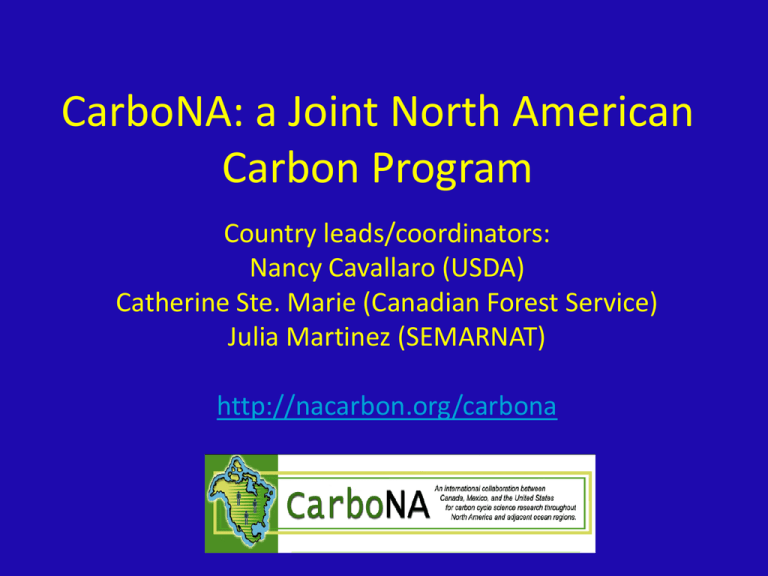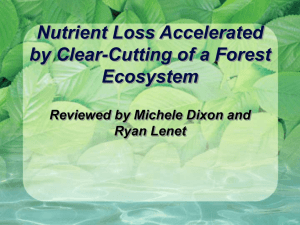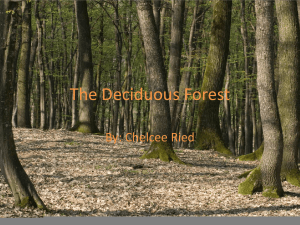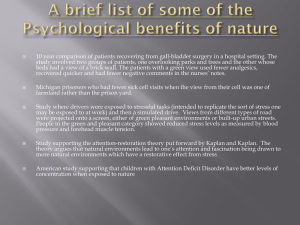Presentation - North American Carbon Program
advertisement

CarboNA: a Joint North American Carbon Program Country leads/coordinators: Nancy Cavallaro (USDA) Catherine Ste. Marie (Canadian Forest Service) Julia Martinez (SEMARNAT) http://nacarbon.org/carbona CarboNA: a Joint North American Carbon Program Science Steering Committee Co-Chairs: Hank Margolis (Laval University) Ben deJong (ECOSUR) Scott Denning (Colorado State University) Statement of Common Interest • The Government Coordination Working Group approved a Statement of Common Interest and Agreement to Work Together – sets forth the justification, purpose, and preliminary structure of the program – Establishes the GCWG, Science Steering Committee – Calls for information exchange/shared results, joint workshops, scientific integration, common measurement protocols where appropriate, international projects/initiatives to be considered for cooperative funding. North American Carbon Program (CarboNA) Science Plan Over-riding science questions: • What is the current carbon budget of North American land, water, and adjacent oceans, and what is the uncertainty of the estimates? • What natural processes control the variability of carbon stocks and fluxes at the continental and sub continental scales? What societal processes determine carbon emissions and sinks at these scales? • What are the past and projected trends in the North American carbon budget, and what factors are expected to be important in the future? When will sinks saturate? Will they become sources? What are possible surprises? • What will be the response of terrestrial ecosystems and coastal oceans to climate change and rising atmospheric CO2? Which stocks and flows of carbon are most vulnerable? • What is the role of economic development, energy technology, trade, and policy actions in driving changes in fossil fuel emissions? • What are the impacts of different greenhouse gas policies on future carbon stocks and fluxes? What data are needed? How can we improve carbon observation systems? North American Carbon Program (CarboNA) Science Plan Special emphasis for international collaboration in North America: • Monitor and predict responses of ecosystem carbon cycles to natural variability in climate and disturbance regimes, to increasing CO2 and to climate change along an ecological gradient from the Arctic to the Tropics; • Estimate continental budgets for atmospheric greenhouse gases using data from land-based, airborne, marine, and space borne platforms including the integration of inventory-based carbon stock estimates for the three member countries; • Establish a working group to identify research needs leading to improved understanding and quantification of carbon cycle processes and budgets in the Gulf of Mexico Basin; • Improve understanding of the current state and likely future changes in carbon cycling in continental coastal ocean environments; of impacts on fisheries and coastal economies; of exchange between coastal oceans and deep ocean basins; and of air-sea gas exchange; North American Carbon Program (CarboNA) Science Plan Special emphasis for international collaboration in North America: • • • • Government–level agreements on data sharing and harmonization, standardization of data collection and management, and criteria for using data, This should include development of trilateral databases with spatial data from tropics to Arctic following international protocols to the extent practicable; Develop an approach for a long-term, consistent, and integrated observation and reporting system for greenhouse gas mitigation across North America; Identify impacts of possible tri-lateral mitigation strategies and opportunities for reducing emissions, increasing greenhouse gas sequestration, sustainable use of biofuels; and how the 3 countries can work together to implement them. (Also how policies in one country might affect the others; Coordinate efforts to develop and deploy decision-support tools to explore the socio-demographic, socio-economic, and socio-political causes of variability in CO2 emissions, as a way to mitigate increases, at the national, state and local level. This could help assess the effectiveness of actions undertaken by stakeholders aimed at mitigating CO2 emissions or adapting to climate change. CarboNA projects: criteria and process Given its mandate and the many and varied sources of funding, CarboNA requires flexible criteria and broad guidelines for designating participating projects and investigators. • A CarboNA project must be of scientific interest to the three countries. It must be relevant to CarboNA Over-riding continental-scale science questions* and is expected to develop results and products that CarboNA needs to achieve its Goals*. • A CarboNA project must include collaboration of scientists from at least two of the three North American countries. • A CarboNA project must clearly address one of CarboNA’s Special emphasis areas for international collaboration in North America*. CarboNA Projects are generally but not necessarily relevant to continental scale analyses, continental gradients or cross-border gradients and regional studies. • A CarboNA project must be endorsed by a minimum of one government agency, or by one member of the CarbonNA Government Coordination Working Group from at least two of the nations participating in CarboNA. Example CarboNA projects • • • • • • • • • • CarboNA-04: Assessing the impacts of fire and insect disturbance on the terrestrial C budgets of forested areas in Canada, Alaska, and the Western US. CarboNA-05: Collaboration with Mexico on Forest Carbon Budget CarboNA-07: Canadian Carbon Program- Flux towers, atmospheric GHG conc., topdown / bottom-up modeling, integration of process and inventory models CarboNA-08: Ameriflux network CarboNA-09: Estimating the Amount, Spatial Distribution, and Statistical Uncertainty of Aboveground Carbon Stocks of the North American Boreal Forest Using the ICESATGLAS Spaceborne Lidar CarboNA-10: Governement Related Initiatives Program CSA-AAFC: Adapting cropping systems to climate variations: deriving above-ground crop biomass from hyperspectral reflectance and radar CarboNA-12: National Carbon and Greenhouse Gas Accounting and Verification System – carbon budget for agricultural land in Canada CarboNA-17: Forest land dynamics and management opportunities for North America CarboNA-18: RESUCCCITIES Initiative to Attain Resilient and Sustainable Relationships among Carbon, Climate and Cities CarboNA-19: Field protocols for terrestrial carbon accounting, and data submission protocols manual (GTOS); based on the west coast design, developed for AmeriFlux and NACP, consistent with 1ha FIA inventory plots. Some examples of relevant collaborations CarbonTracker “Carbon Weather” January (net CO2emission) CarbonTracker™ Long-term Observations July (net CO2 uptake) An emerging highaltitude observatory in Mexico yields information on broadscale fluxes of GHGs Carbon Dioxide (ppm) 18,700 ft. Sulfur Hexafluoride (ppt) Sierra Negra Orizaba (Alert, Canada, coop since 1985) Recent Atmospheric Monitoring Site in Saskatchewan • • • Cooperative arrangement between NOAA and EC Now has continuous measurements from tower (not shown here) Used in CarbonTracker FLUXNET-AmeriFlux-CCP Networks Fluxnet-Canada: 2002-2007 Canadian Carbon Program (CCP): 2007-2010 Slide 15 CarboNA-06: Application of the Carbon Budget Model of the Canadian Forest Sector (CBM-CFS3) to Mexico (slides from Werner Kurz, Canadian Forest Service) • Collaborative project between ConaFor, EcoSur, other Mexican research centers and Canadian Forest Service • Support for reporting of GHG emissions and removals, and analysis of REDD baseline and alternative scenarios. • Currently testing of model at several pilot sites in wide range of ecological conditions in Mexico • Preparation of input data for national-scale application of the model Carbon Budget Model of the Canadian Forest Sector (CBM-CFS3) • An operational-scale model of stand and landscape-level forest C dynamics. • Allows forest managers to assess carbon implications of forest management: increase sinks, reduce sources • Compliant with IPCC reporting guidelines • Freely available at: carbon.cfs.nrcan.gc.ca Kurz et al. 2009, Ecol. Modelling CBM-CFS3 Application in Mexico • Developed spatial stratification for compilation of national data. • Conducted 2 workshops: project planning and user training. • Spanish-language interface for CBM-CFS3 under development. 94 Spatial Units Forest stands > 60,000 + Classifiers 7 Ecoregions & 32 States CBM-CFS3 Application in Mexico Contacts: Dr. Ben de Jong, Ecosur Marcela Olguin, Ecosur Dr. Werner Kurz, Canadian Forest Service CarboNA-09: Estimating the Amount, Spatial Distribution, & Statistical Uncertainty of Aboveground C Stocks of the N.A. Boreal Forest Using ICESAT-GLAS Spaceborne Lidar (slides from Hank Margolis, Laval University, Quebec) • Idea was the ICESat satellite carried a lidar to measure polar ice sheet elevation could also be sensitive to forest biomass. • Pilot study where Quebec scientists worked closely with scientists at the NASA Goddard Space Flight Center to use an airborne lidar to sample both provincial forest inventory plots and the ICESat ground tracks. • This allowed them to scale the >100,000 ICESat laser pulses acquired in Quebec to estimate aboveground forest biomass for the province. • The successful pilot study has allowed US and Canadian scientists to expand the approach to the entire boreal forest of North America. • And hopefully to soon work with Mexican collaborators to apply the approach to the entire forest area of North America. 97 GLAS Orbits in Quebec – Autumn 2003 104,044 pulses CarboNA-09: Estimating the Amount, Spatial Distribution, & Statistical Uncertainty of Aboveground C Stocks of the N.A. Boreal Forest Using ICESAT-GLAS Spaceborne Lidar • Idea was the ICESat satellite carried a lidar to measure polar ice sheet elevation could also be sensitive to forest biomass. • Pilot study where Quebec scientists worked closely with scientists at the NASA Goddard Space Flight Center to use an airborne lidar to sample both provincial forest inventory plots and the ICESat ground tracks. • This allowed them to scale the >100,000 ICESat laser pulses acquired in Quebec to estimate aboveground forest biomass for the province. • The successful pilot study has allowed US and Canadian scientists to expand the approach to the entire boreal forest of North America. • And hopefully to soon work with Mexican collaborators to apply the approach to the entire forest area of North America. CarboNA-09: Estimating the Amount, Spatial Distribution, & Statistical Uncertainty of Aboveground C Stocks of the N.A. Boreal Forest Using ICESAT-GLAS Spaceborne Lidar • Idea was the ICESat satellite carried a lidar to measure polar ice sheet elevation could also be sensitive to forest biomass. • Pilot study where Quebec scientists worked closely with scientists at the NASA Goddard Space Flight Center to use an airborne lidar to sample both provincial forest inventory plots and the ICESat ground tracks. • This allowed them to scale the >100,000 ICESat laser pulses acquired in Quebec to estimate aboveground forest biomass for the province. • The successful pilot study has allowed US and Canadian scientists to expand the approach to the entire boreal forest of North America. • And hopefully to soon work with Mexican collaborators to apply the approach to the entire forest area of North America. ICESat-1 Coverage 11 million pulses in boreal CarboNA-09: Estimating the Amount, Spatial Distribution, & Statistical Uncertainty of Aboveground C Stocks of the N.A. Boreal Forest Using ICESAT-GLAS Spaceborne Lidar • Idea was the ICESat satellite carried a lidar to measure polar ice sheet elevation could also be sensitive to forest biomass. • Pilot study where Quebec scientists worked closely with scientists at the NASA Goddard Space Flight Center to use an airborne lidar to sample both provincial forest inventory plots and the ICESat ground tracks. • This allowed them to scale the >100,000 ICESat laser pulses acquired in Quebec to estimate aboveground forest biomass for the province. • The successful pilot study has allowed US and Canadian scientists to expand the approach to the entire boreal forest of North America. • And hopefully to soon work with Mexican collaborators to apply the approach to the entire forest area of North America. A call for collaborators, proposals • A list of currently proposed projects and profiles can be found on the CarboNA website: http://nacarbon.org/cgibin/carbona/investigations/inv_profiles.pl • Some are looking for collaborators—Yukon river, Health and Agriculture, Crop Biomass, Ocean Acidification, RESUCCCITIES • We welcome additional projects • NACP projects may be co-listed with CarboNA if they meet the criteria NACP Interim syntheses underway• Most include Canadian scientists, some also include Mexican scientists – – – – – – – Regional/continental comparison-CA, MX Site-based model-data comparison-CA Midcontinent intensive regional syntheses-? Non-CO2 greenhouse gas synthesis-CA Disturbance effects on carbon fluxes-CA, MX Coastal ocean carbon cycle synthesis-CA, MX MsTMIP Synthesis (multi-scale synthesis and intercomparison project)-? Slide 29 Some observations • U.S. looking for international collaboration on human interactions and cities • Need for more ocean/coastal coordination--take advantage of increased interest/funding in the Gulf of Mexico on the part of MX due to the oil spill • Take advantage of new initiative in MX (CONACYT) for and observations network-coordinate with NEON? • Horizontal movement of carbon-riverine fluxes, estuarine processes, wetlands, interfaces between ecosystem types • Take advantage of U.S. initiative in soil carbon protocols, measurement and modeling • Some programs and observations systems are in jeopardy-Can more prominent international interest influence national funding for systems and studies in danger of losing funding?








